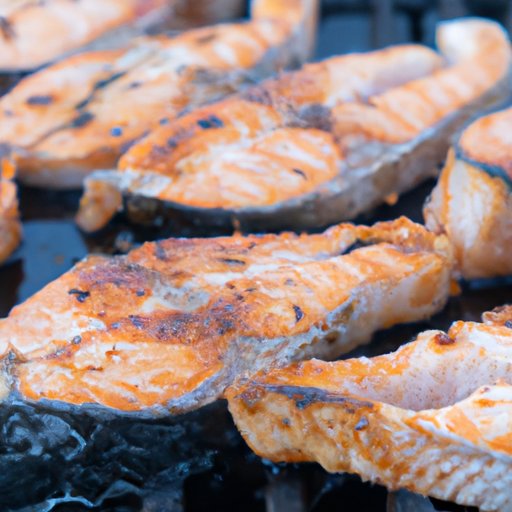
Introduction
Grilling salmon can be a bit tricky. You don’t want to overcook it and make it dry and tough, but it’s also important to ensure that it’s cooked through and safe to eat. So, how long do you grill salmon for? In this article, we’ll provide a comprehensive guide to grilling salmon perfectly, including tips and tricks from professional chefs and expert advice on seasoning and marinades.
Grilling salmon 101
The first step in grilling perfect salmon is choosing the right type of salmon. Opt for fresh, high-quality salmon that has a bright, vibrant color and smells like the ocean. When preparing the grill and the salmon, it’s important to clean the grill grates with a wire brush to remove any debris, then oil the grates to prevent the salmon from sticking. Season the salmon with salt and pepper, or a favorite marinade or rub.
How to grill salmon without overcooking
One of the biggest challenges when grilling salmon is overcooking it. To avoid this, understanding the cooking process is key. Try using indirect heat by cooking the salmon on the cooler side of the grill, or by using a method called “planking,” where the salmon is cooked on a wooden plank that has been soaked in water. Another useful tool is a meat thermometer, which can help you monitor the salmon’s internal temperature and prevent overcooking.
The ultimate guide to determining salmon doneness on the grill
Aside from using a meat thermometer, there are visual cues and touch tests to help you determine if your salmon is done cooking. Look for the salmon to turn from translucent to opaque, and for the white protein to start to rise to the surface of the salmon. When touching the salmon, it should feel firm but still give slightly when pressed. The internal temperature of the salmon should reach at least 145 degrees Fahrenheit.
The science behind grilling salmon
Understanding the science behind grilling salmon can help you avoid common mistakes and achieve the perfect texture and flavor. Salmons are high in protein and fat, which makes them more delicate and prone to drying out during cooking. By cooking the salmon at the right temperature and for the right amount of time, you can ensure that it stays moist and flavorful.
Time and temperature: The key factors in grilling perfect salmon
When it comes to grilling perfect salmon, time and temperature are key. For larger cuts of salmon, aim for a cooking temperature of around 350 degrees Fahrenheit and cook for around 12-15 minutes per inch of thickness. However, factors like the thickness of the salmon and the grill’s temperature can affect cooking time, so it’s important to adjust accordingly.
From marinades to rubs: Flavorful ways to spice up your grilled salmon
One of the benefits of grilling salmon is the ability to infuse it with a variety of flavors. Try experimenting with different marinades, such as Asian-inspired flavors like soy sauce, ginger, and garlic, or a citrusy marinade with lemon and herbs. Rubs are another great option, with options ranging from simple salt and pepper to more complex spice blends like Cajun or Mexican. Don’t be afraid to get creative and try different combinations!
Grilling salmon like a pro: Expert advice from top chefs
To take your salmon grilling game to the next level, we’ve gathered tips and tricks from professional chefs. Tom Douglas, a Seattle-based chef, recommends using a high-quality fish spatula to prevent sticking, while Chris Lilly, a pitmaster and cookbook author, suggests using a digital meat thermometer with a probe to monitor cooking temperature. Additionally, using a fish basket or grilling mat can help keep the salmon from sticking to the grill grates.
Conclusion
Grilling salmon doesn’t have to be intimidating. By following these tips and tricks, you can grill up a perfectly moist and flavorful salmon every time. Whether you use a marinade or a rub, or opt for direct or indirect heat, the most important thing is to have fun and experiment! So, fire up the grill and enjoy a delicious meal.





